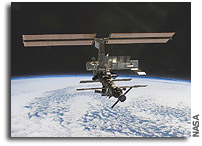ISS Science Status Report for week ending Nov. 15, 2002
 Middle school students conducted fall geography research this week courtesy
Middle school students conducted fall geography research this week courtesy
of the International Space Station.
The Earth Knowledge Acquired by Middle School Students (EarthKAM) science
team began photography operations on Monday and continued throughout the
week using an automated camera in a window of the orbiting research lab.
Ten schools participated in this week’s operations. More than 600 images
taken on 46 orbits have been downlinked to the science team for distribution
to the schools. The experiment allows students around the country to send
commands to the camera and take pictures of geographical or manmade features
that they have selected for various classroom studies. The digital images
are transmitted to Earth, where students can retrieve them via the Internet
in a matter of hours. No EarthKAM operations were scheduled until 2003, but
changes in Russian and U.S. launch schedules permitted time for the
educational research program.
On Thursday, selected members of the crew participated in the Crew
Interactions research program. The experiment consists of a computer-based
survey of roughly 70 questions. Scientists hope to identify and
characterize
interpersonal and cultural factors that could affect the performance of the
crew, as well as ground support personnel also participating in the survey.
On Thursday, the crew collected background radiation readings on the EVA
Radiation Monitoring (EVARM) experiment. The experiment consists of
dosimeter badges worn by astronauts in the cooling undergarments of their
spacesuits during spacewalks. Measurements taken inside the Station will be
compared to radiation readings recorded after spacewalks. The EVARM badges
will be worn next on the STS-113 Shuttle mission to the Space Station
scheduled for November 18. EVARM is the first experiment to measure
radiation received by specific parts of the body, including the eyes,
internal organs and skin.
Downlinked images last week of Arabidopsis thaliana plants being grown in
the Plant Generic Bioprocessing Apparatus indicated that the plants have not
grown as fast as expected. The science team decided this week to let the
plants continue growing and harvest them after they are returned to Earth.
The focus of this commercial experiment is to better understand the role of
gravity on lignin – a plant substance that affects the strength of plant
stalks and stems.
Crew Earth Observation photography subjects for this week included Buenos
Aires; American Samoa; Beijing, Tianjin, Guangzhou and Hong Kong, China; the
Nile River Delta, Madrid; Nairobi, Kenya, Mt. Kilimanjaro in Africa;
Patagonian Glacier fields, and fires in Madagascar.
Troubleshooting work on the ARCTIC 1 freezer in the Destiny lab scheduled
for Thursday was deferred until after the STS-113 Space Shuttle mission to
the Space Station. ARCTIC 1 and an identical unit, ARCTIC 2, are used to
preserve biological specimens for return to Earth. Both units malfunctioned
recently. No samples are currently stored in either unit. The operations
team has decided to bring the ARCTIC 2 freezer home on an upcoming Shuttle
mission.









